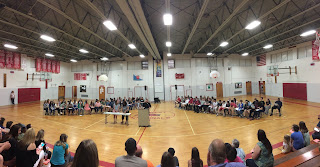"What
is more beautiful? How the moon lets the sunshine throughout the day or the
way the sun lets the moon glimmer at night? "
On May 18, the Ford Motor Company Astronomy Club came to West Middle
School to help students ponder this question. Members Gordon Hanson, John
McGill and Sandra Macika spoke to our students about various aspects of
astronomy.
Sandra
Macika was a NASA employee for seven years. She brought several meteorites for
the students to hold and closely examine. She discussed how the meteorites were
formed. Many of the meteorites came from the cores of “planetismals.”
Crystal
patterns in the meteorite tell how slowly or quickly they cooled before
entering Earth's atmosphere. Ms. Macika has meteorites from several different
countries including Sweden, Russia, Africa, and Peru.
She
also had examples of “tektites.” Tektites come from giant meteorites.
Meteorites hit the earth melting the affected dirt. This melted dirt flies up
out of the atmosphere. As gravity pulls it back down to Earth, it cools and
becomes tektites or dirty glass.
Mr.
Hanson and Mr. McGill set up their very expensive telescopes in the school
parking lot. One telescope was aimed directly at the sun. Through this
telescope you could see the sun through a filtered lens. A “prominence” or
magnetic field was visible. The other telescope was pointed toward the moon.
Amazingly, the moon craters could be seen. One crater even had a mountain in
its center.
Mr.
Gordon Hanson and Mr. John McGill cautioned us to never look directly at the
sun. Since our eyes have very few pain receptors we may permanently
damage our eyes without even knowing it. The blindness may not be evident for
24 hours later.
These
gentlemen gave us the exciting news that on August 21, 2017, there will be a
total solar eclipse here in the United States. The sun's path will go from
Oregon to South Carolina. Depending on the sun's location along the path,
the solar eclipse may only be seen for 30 seconds to two-and-a-half minutes.
They
also suggested that the students investigate the Ford Motor Company Astronomy
Club website to find dates of other astronomy events. Some events are held at
Island Lake State Park. They also encouraged the students to visit Henry Ford
College Planetarium on Wednesday evenings at 7:30. There is no admission
charge.
In
addition, students and their parents may go to the Lincoln Park High School
planetarium on Friday and Saturday nights when there is a clear sky.
We
wish to sincerely thank these members of the Ford Motor Company Astronomy Club.
Their presentation was a wonderful extension of our eighth grade science
curriculum. Their visit may have sparked a lifelong hobby of looking at our
universe. Hopefully, they motivated our students to pursue astronomy as a
career. Who knows, one of our West alums may one day become an astronaut!
Submitted
by Sara Bochenek































































